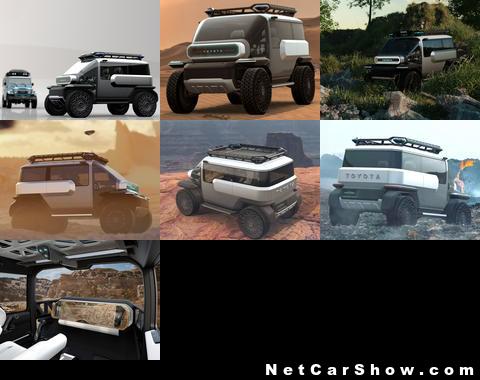Toyota Baby Lunar Cruiser Concept
CALTY is always thinking about what's next, so it's no surprise that its latest creation was inspired by a vehicle built to drive on the moon. The Baby Lunar Cruiser (BLC) blends design cues from the original FJ40 Land Cruiser with the futuristic capabilities of an interplanetary exploration vehicle. BLC draws inspiration from the real Lunar Cruiser being developed by the Japanese Aerospace Exploration Agency (JAXA) and Toyota.
Propelled by in-wheel electric motors and controlled by dual joysticks, the BLC's compact footprint and airless tires give it unparalleled maneuverability. It also boasts exceptional outward visibility thanks to its protruding glass canopy and a panoramic, augmented reality dashboard display. Heritage cues include a "TOYOTA" script grille up front, complete with a full array of cameras and lidar/radar sensors, and a split tailgate configuration in back. Highly adjustable spaceframe seats and M.O.L.L.E. panels throughout give the interior the flexibility to adapt to any kind of adventure.
California Dreamin'
Established in 1973 in El Segundo, California, CALTY was the vision of Dr. Shoichiro Toyoda and Eiji Toyoda. The new studio was deliberately kept quiet, allowing it to develop a unique identity and provide fresh, creative inspiration to Toyota's global design headquarters in Japan.
"California was a youthful, vibrant epicenter of fresh ideas, a cool car culture, and the glamorous movie industry that inspired CALTY to create innovative designs and establish new trends," said Kevin Hunter, president of CALTY Design Research.
When CALTY decided to expand and relocate, it didn't go far, moving down the coast to Newport Beach in 1978. That same year, CALTY's first production car design, the second-generation Celica, became a global hit and the designers haven't looked back since.
Five Decades of Daring Designs
Throughout the decades, CALTY's direction and role evolved alongside Toyota's growth. The 1970s was the decade of discovery and research. The initial years at CALTY under studio chief, Executive Vice President Mamoru Yaegashi were used primarily for conducting research on future trends in design.
One such project was a proposal for an off-road vehicle based on the Land Cruiser. CALTY even went so far as to build a one-fifth scale model that was shown to executives from TMC for review.
CALTY's designers worked quietly in the shadows during this time, diligently researching the market in and around Southern California. Experimentation was encouraged, so the designers didn't limit themselves strictly to cars and trucks.
The 1980s introduced the studio's shift toward exploring innovative design language and techniques. There was plenty of excitement within the design development teams who were given full freedom to push the envelope of artistic process and pure creativity in ways that had not been allowed in major studios at the time.
Naturally, some of the designers turned their thoughts to high performance sports cars, the first of which was the MX-1 in 1983. It featured a mid-engine layout and a scissor-style doors.
A couple years later, a second mid-engine sports car concept was not only designed, but built in house by CALTY out of fiberglass reinforced plastic (FRP). It featured gullwing doors and a swing arm steering wheel that could accommodate either left- or right-hand drive.
During the 1990s, CALTY contributed significantly to Toyota's production vehicles for the North American market. Notable designs from this era include the 1995 Tacoma, the 1997 Prius and the 2000 Avalon.
It also worked on some designs that didn't make the final cut, notably the fourth generation Supra, or A80 as it was known internally. CALTY's intent was to take the Supra in the direction of a "pure sports car," rather than continue with the previous models' Grand Touring character. They gave it a long hood and a linear bulge so the engine bay could accommodate a large inline-6 engine.
They also enlarged the functional elements-wheels, engine, rear spoiler, door handles, mirror mount-to heighten the Supra's already distinct DNA. You can see traces of CALTY's advanced concept model in TMC's production version of the fourth-generation car, which was introduced in 1993.
With the growth of production car development in North America, CALTY established a design studio in Ann Arbor, MI in 2004 which revolutionized local production design efforts, resulting in the creation of North American-specific models like the Tundra, Tacoma, Avalon and Sienna.
The 2010s brought an era of fun-to-drive, exciting vehicles, thanks to Toyota CEO Akio Toyoda's passion and declaration of "no more boring cars." Highlights from this decade include: The 2012 Fun-Vii concept, deemed a "smart phone on wheels"; the 2012 Lexus LF-LC, which became the 2018 Lexus LC500 and ushered in a new design language for Lexus; and the 2014 FT-1 concept, which became the 2020 Supra, a personal sports car favorite of CALTY.
CALTY still indulged its wild side at this time, however, with concepts like the Scion NYC, which explored future transportation trends in big cities.

![2025 BMW M3 CS Touring [UK]](/R/BMW-M3_CS_Touring_UK-Version-2025-thb.jpg)





































